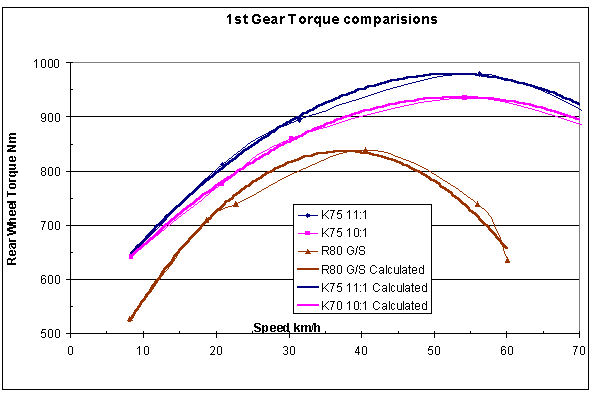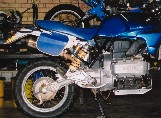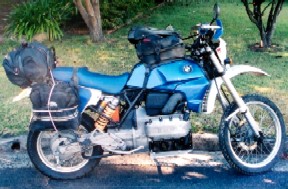
I have a BMW R80 G/S that has been very good, but it does not like high temperatures, creek crossings,
constant high speeds and requires a fair amount of maintenance. The K model motors have been very reliable,
economical and have reduced maintenance compared to airhead motors.
The K75 is lighter and smaller than the K100, heaver than the R80G/S but not as heavy as a R1100GS.
The electrical complexity of the K could be a problem if a fault occurs in the field.
However the K electrics are more reliable than the airhead electrics.
In part this is due to the water cooling of the K reducing the temperature
fluctuations and maxima experienced by the electronics on the R series.
And the fact that the K series are a little newer.
A second hand K75 GS has come up for sale. It has had the suspension modifications done,
together with the frame, stands, bash plate and rear wheel modifications.
Cheaper to buy it with these things done, and the previous owner has done some testing of the mods!

The above torque curves are calculated from
Engine and gear box -
Maximize engine flexibility so as to obtain a minimum "walking" speed to trickle through rough spots?
The K gear box compare to the airhead is a closer ratio gearbox.
The K has a top to bottom gear box ratio of 2.69 , 8.7 for the engine top to bottom speed
making an overall maximum speed to minimum speed ratio of 23.40.
The airhead has a top to bottom gear box ratio of 2.93,
7.4 for the engine top to bottom speed making an overall top to bottom speed ratio of 21.61.
So the K is overall more flexible, but would be even better with a wider ratio gear box.
I am assuming that the idle speed is the minimum speed for both motors in first gear.
This is where the K has a disadvantage compared to the R,
the R has less torque at idle thus actual decreasing its speed more readily than the K does.
So when loaded the R goes slower than the K.
Ideally set for a cruise speed of 140 km/h. Top speed say 180 km/h? That would be a 10% reduction in overall gearing, from a final ratio of 3.2 to 3.52 .. However the lowest available ratio is 3.36 i.e. a 5% reduction so that would lower the top speed from 200 km/h to 190 km/h. I would like a 5% lower bottom gear for the K gear box, to achieve a total 10% reduction. Is there such a thing? Maybe it will have to be a special, if so I think leaving the standard rear gearing, and lower bottom gear say 15%? This would keep the cruise speed and economy, and provide a good low speed gear at around 7.3 km/h with the clutch fully engaged. If so that would make the gear box as wide in ratio as the airhead.
The idle speed is set for smooth running with no load and no throttle.
The motor will run at a lower speed - other wise the starter motor would have to spin the motor up to
at least the idle speed to start the motor!
The K motor will run lower if the idle speed is adjusted down. The reason why you should not do this
are the motor may run rough,
possibly stall without added throttle, and reduced cam chain (and chain slider) life.
So setting the idle speed down can be done, but I would only do it for the time I needed the speed/torque reduction.
But I need to experiment with this. It is certainly a cheap option compared to a gearing change.
The following are some of my thoughts on making a K75 G/S before I bought the bike. If you want to see further mods then you will have to look at my other page on improvements to a K75 G/S.
 Replace front end with a dirt bike front end - Includes front wheel (21 inch), triple clamps, leavers,
Replace front end with a dirt bike front end - Includes front wheel (21 inch), triple clamps, leavers,
Along with this goes the front brake, say 300 mm diameter disk with a 4 pot caliper.
6 pot calipers I think are overkill provided you are not carrying a lot of weight.
Ensure the forks are strong enough for the weight carried. The triple clamp may need to be made up to
suit the bmw head stem, the new forks and the geometry required. Suspension travel between 250 mm and 280 mm.
The actual bike came with 300 mm travel and a 6 pot caliper.
 The R80 G/s has 170 mm travel on a 415 mm swing arm length (pivot to axle centre), which is around 12 degrees
movement in both directions with respect to the gear box output flange. My K11LT has about 16 degrees on the
rear paralever joint.
The R80 G/s has 170 mm travel on a 415 mm swing arm length (pivot to axle centre), which is around 12 degrees
movement in both directions with respect to the gear box output flange. My K11LT has about 16 degrees on the
rear paralever joint.
Replace rear shock, extend swing arm. New mounting points for the shock may be required.
The actual bike ended up with around 213 mm travel, around plus and minus 15 degrees.
All the K bikes come with alloy wheels.
Enduro and Dirt motorcycles usually have spoked wheels... because they 'give' a little
with impacts, this flexing makes them undesirable on hard smooth surfaces.
But on dirt the flexing absorbs some part of the impact, reducing the possibility of
damage. Some people think spoked wheels are stronger than alloy wheels.
What ever, I would like a spoked rear wheel. Tradition? Maybe so, but if there was something better you would
see them in competition.
The K75C came with a drum brake, this makes the wheel changes a little more complex involving the drum.
It also can have a brake chatter as the suspension rises and falls and the brake is applied.
It would be better if either the brake was cable operated or the pivot point for the brake was at
the swing arm pivot point.
Better with the disk rear brake of the S or RT models as this over comes the wheel changing complication and
the brake problem.
For spoked rims two possibility exist, the rear wheels off the R100R or R100GS.
The K75S comes with a 130/90 - 17 tyre on a 2.75 rim (weight 229kg wet).
The R100 GS come with
130/80 17; 2.50 rim (weight 210kg wet), R1100 GS with 150/70; 4.00 rim (weight 243kg wet),
R100R 140/80 17; 2.50 rim (weight 218kg wet).
Either the R100GS or the R100R rear wheels could be adapted to fit. Both of these are tubeless rims.
Suitable tubeless dual sport tyres are available from Prielli (MT90) and Metzeller (Tourance and Enduro 4)
in both 130 and 140 sizes. Adaptors to the hub are required, for the drum brake the shoes must be extended outwards,
for the disk brake I think a spacer is required.
Strengthen and modify top shock mount to increase rear wheel travel.
Move rear mudguard back to accommodate longer swing arm if fitted.
One of the frame failure points is between the pillion and rider just after where the bottom brace joins
the top part of the frame. Another failure point is around the steering head.
Lower foot pegs, replacing the cast aluminium mounts with a soft (bends rather than fracturing) fitting.
Seat height - not too high! Say 860mm?
If the footpegs are lower then lower the seat height by a similar amount.
Protection for the sump, water and oil pump. The bash plate can mount to the sump tube used for the crash bars. It should protect the sump area from rocks and sticks, while letting cooling air circulate. It must not significantly increase the time taken for oil changes, or oil filter changes. Possibly the front mount should pivot, so that once the rear mounts are undone the plate can be moved out of the way giving access to the sump. It should be light, quickly removable and easy to repair/replace.
 Extend lengths for the increased ground clearance, and broaden contact surface for sand and earth support.
The centre stand bolts to the bottom of the gear box,
this mounting could be moved downwards using spacers until it starts to reduce ground clearance.
Possibly the new footpeg mounts could use these spacers for the bottom mounting points.
Extend lengths for the increased ground clearance, and broaden contact surface for sand and earth support.
The centre stand bolts to the bottom of the gear box,
this mounting could be moved downwards using spacers until it starts to reduce ground clearance.
Possibly the new footpeg mounts could use these spacers for the bottom mounting points.
Exhaust mods may be needed for clearance?
 This bike is not intended for tight 'trials' type work, nor was the R80G/S...
it is intended for touring dirt roads where a normal road bike has problems.
Must carrying enough supplies for days away from stores, most dirt bikes don't have the load capacity.
Probably why dirt dikes are so light, they don't need the strength to carry the weight, nor are they expected
to last as long.
The weight of the K compared to the airhead is a little more. The centre of gravity is
not much higher as the airhead carries the alternator and starter motor high compared to the K
where as the K has the radiator carried high. Water is lighter than metal...
This bike is not intended for tight 'trials' type work, nor was the R80G/S...
it is intended for touring dirt roads where a normal road bike has problems.
Must carrying enough supplies for days away from stores, most dirt bikes don't have the load capacity.
Probably why dirt dikes are so light, they don't need the strength to carry the weight, nor are they expected
to last as long.
The weight of the K compared to the airhead is a little more. The centre of gravity is
not much higher as the airhead carries the alternator and starter motor high compared to the K
where as the K has the radiator carried high. Water is lighter than metal...
Currently (April 2002) the bike weights about 205 (113 rear) kg wet (full tank of fuel, oils and coolant, but no tool kit) [I used the bathroom scales so inaccurate].
My old R80 G/S is suposed to be 192 kg (13 kg less) [with tools, I guess that the tools weight 2 kg?]
Electrics (simplify)
It has a husky speedo fitted that contains the idiot lights. This replaces the original instrument cluster.
The idiot lights are not very visible. It does have a trip meter. Other than this it has the standard electrics.
You can e-mail me at Yahoo.
Back to my home page
Dated 22 April 2002